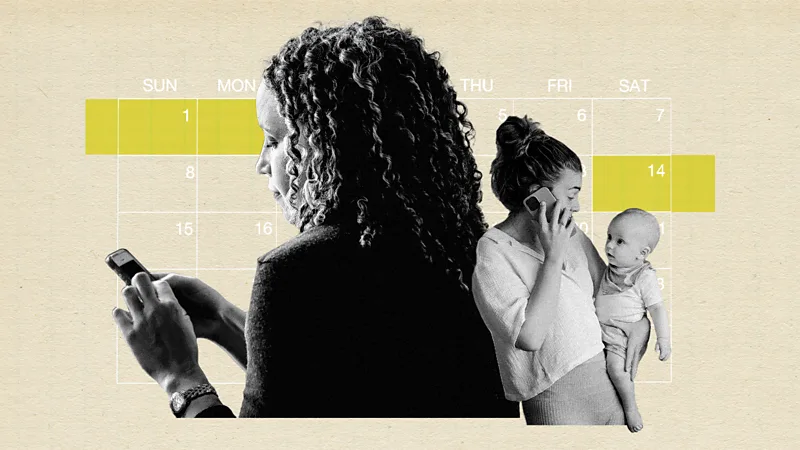- Body of Osman Hadi Returns to Dhaka From Singapore Late |
- Fakhrul condemns attacks on media, calls for unity, justice |
- 2 cops among 4 hurt in clash outside Indian Assit H.C. in Ctg |
- Inqilab Moncho urges people to avoid violence |
- Hadi’s death: Prothom Alo, Daily Star offices set afire |
How technology creates hidden work for women

Women tend to take on most of the domestic online tasks, according to recent research (Credit- BBC-Getty Images)
When it comes to using technology at home, women tend to do more of the day-to-day online work for the family, creating an extra digital burden.
My phone pings and it's the school chat group reminding us that it's a dress-up day. I scramble to fashion an outfit together for our children to wear. I do this without thinking about it, before my partner has a chance to help.
This is a common occurrence in many households, because despite men taking a more active role in parenting than in recent history, women still tend to be seen as the household organisers.
It's now been well established that in heterosexual relationships, women also do more of the hidden labour – the anticipating, planning and organising of the tasks that helps family life function. It creates a substantial mental workload at the intersection of cognitive and emotional labour. Less obvious is the fact that technology is exacerbating this, putting women at risk of digital overload and even burnout.
Clearly technology can help us be more productive in many areas of our lives. But at home, it is evident that technology is adding to women's already busy mental workloads. A recent cross-national study analysed data from the European Social Survey of more than 6,600 parents from 29 countries who had at least one child and one living parent. It found that the mental load on women, especially mothers, is exacerbated by technology. There appears to be a gender division of labour when it comes to digital communication regarding work and family life.
The research team looked at technology use among the respondents. Men tended to use technology most at work but women used technology both at work and home. "We find that women are more likely to be exposed to the double burden of digital communication in both work and family life," says lead author of the study Yang Hu from Lancaster University in the UK, who conducted the study alongside Yue Qian from the University of British Columbia in Canada. Women who worked from home also experienced more of this double burden.
It is an issue that has worsened as we conduct more of our lives online, and as working from home has become more common following the Covid-19 pandemic. Women are 1.6 times more likely than men to juggle dual-high digital communication both at work and at home, the researchers found.
Examples of what this means in practice aren't hard to find. My local mum's group is more active than the dad's group, and has many more participants (several hundred). This is where mums chat about events, rashes and parenting concerns. Even if a group is labelled as a parent's group, the most vocal participants, I find, are usually women.
One mum I know told me that she divides some of this digital communication with her partner, with her on the class chats and him on the emails – but unfortunately emails are a lot quieter than the instant chatter of texts. Household groceries, clothes and school supplies can all be bought digitally too, a digital extension of tasks women tend to do more of.
Many couples set out to be egalitarian but gendered patterns often creep in. That's why it's important to recognise the role technology plays when attempting to better share the load at home. We tend to use our digital devices for leisure as well as work, making it hard to delineate where personal use is recreational versus for the family, meaning it's an under-recognised form of labour. As the late feminist scholar Joan Acker highlighted, to challenge inequality we need to make the invisible visible. If you can't see it, we're not likely going to be aware of it.
Another contributing factor that leads women to take on more digital work is linked to the fact that they tend to work more flexibly than men, taking on part-time roles for childcare needs. This exposes "the flexibility paradox", which is the idea that flexible working exploits women more than men, as it further emphasises their primary caregiver status. Working from home is often offered as a way for individuals, particularly women to juggle family and work responsibilities, says Hu, but that very flexibility can lead women to taking on more of the childcare organisation, which today is largely organised digitally.
The unfortunate consequence of this is that the more women take on at home, the less mental headspace they have for their professional lives, contributing to the gender pay gap, increased stress and higher relationship dissatisfaction.
Heejung Chung a sociologist at King's College London in the UK who studies flexibility in the workplace, says flexible working exacerbates all aspects of housework and childcare. "Women who work flexibly or from home tend to do more housework and childcare compared to women who do not, because they have the flexibility to squeeze in as many paid and unpaid hours into their day as possible." - BBC News

